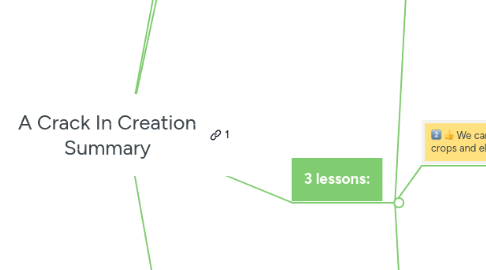
1. 1-Sentence-Summary:
1.1. A Crack In Creation will teach you all about the power of gene editing that is made possible with CRISPR by detailing how it works, the benefits and opportunities it opens up, and the ethical risks of using it on humans.
2. Favorite quote from the author:
2.1. "The power to control our species' genetic future is awesome and terrifying. Deciding how to handle it may be the biggest challenge we have ever faced." - Jennifer A. Doudna
3. 3 lessons:
3.1. Scientists have found a way to utilize the natural phenomenon of CRISPR that happens in bacteria.
3.1.1. The acronym CRISPR stands for clustered regularly interspaced short palindromic repeats. Think of it more simply as a part of bacterial DNA that lets us cut and modify genes as we please.
3.1.2. To understand how this all works, you need to know about three parts that allow these bacteria to cut through virus DNA to fight it:
3.1.2.1. CRISPR-associated, or CAS gene, specifically the Cas9 gene
3.1.2.2. CRISPR RNA
3.1.2.3. tracrRNA
3.1.3. Each of these three components has an important role in what bacteria does to modify DNA.
3.1.3.1. The Cas9 gene lets the bacteria cut through virus DNA to disable its effects. It knows where to slice because CRISPR RNA acts as a messenger to tell Cas9 where to go make the snip. Last we have tracrRNA, which turns on the cutting action.
3.1.4. But could researchers use CRISPR to cut specific DNA in a lab? It turns out this is possible.
3.1.5. When CRISPR makes it’s slice, there’s a space right afterward that the body begins to repair itself.
3.1.6. Utilizing that opportunity, scientists can insert whatever DNA sequence they want to, which modifies the traits of the organism.
3.1.6.1. Thus, we can change whatever we desire to be different about our genes. This can upgrade many aspects of our lives.
3.2. We can use gene editing to grow healthier crops and eliminate some diseases.
3.2.1. The citrus industry, for example, has a problem with what’s called yellow dragon disease. Utilizing gene editing, we could end the decimation of plantations in Asia that this plague causes.
3.2.2. We can also modify our food to be better for us, like taking trans fats out of soybean oil for example.
3.2.3. Some pigs in Canada have already been genetically modified to have better digestion. This reduces phosphorus in their waste that causes algal blooms that kill aquatic animals.
3.2.4. For humans, we’ve got over 7,000 diseases that result from a single gene mutation each. All of these could be gone with CRISPR.
3.2.4.1. Even HIV, which affects millions around the world, may be preventable with gene editing.
3.2.4.2. It could also find a cure for fatal diseases like muscular dystrophy.
3.2.5. This amazing new tool even has a chance at stopping cancer entirely.
3.2.5.1. Because DNA mutations cause cancer, the ability to cut and modify DNA at will might be able to stop it.
3.3. Although this new breakthrough sounds all good, we must answer some questions and ethical implications about it.
3.3.1. The author’s breakthrough research was going well in 2014 when an entrepreneur had an interesting pitch to co-author Samuel Sternberg. They wanted him to help create a “CRISPR baby.”
3.3.2. Sternberg declined this offer, but this began a string of ethical questions about gene editing that we still need to answer.
3.3.3. Is it ethically okay to use something like this to choose a baby’s gender or modify it to be stronger or prettier?
3.3.4. Concerns began to arise in the author’s mind about someone abusing CRISPR.
3.3.4.1. It got so bad at one point that she once had a dream that she met Adolf Hitler, who asked about the process. The thought of a psychopath like him getting this technology terrified Doudna.
3.3.5. Doudna suggests reviewing three themes as we figure out the next steps of gene editing technology.
3.3.5.1. The first is safety, which she feels will soon be taken care of as the science of CRISPR advances.
3.3.5.2. Next is the ethical component. While eliminating diseases is amazing, some might wonder why we should stop there. It may not be long before unregulated gene editing allows people, mostly the rich, to buy better bodies for themselves.
3.3.5.3. The last point is about the regulations that governments must make.
3.3.5.3.1. This has already begun with an International Summit on Human Gene Editing back in 2015.
3.3.5.3.2. We can only hope that meetings like this one will continue to progress efforts to enforce limits.
